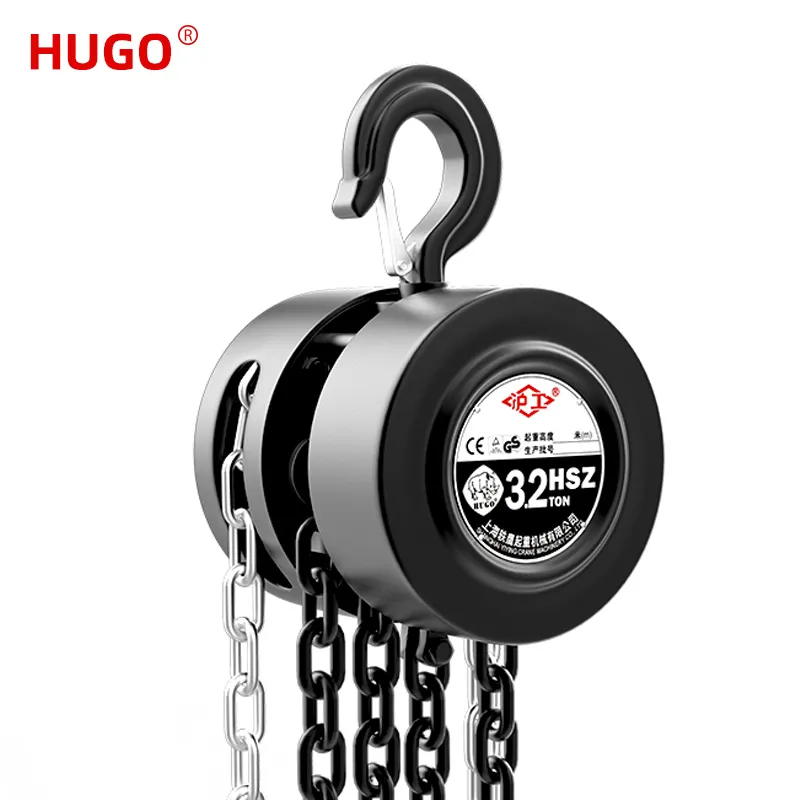
- English
- Español
- Português
- русский
- Français
- 日本語
- Deutsch
- tiếng Việt
- Italiano
- Nederlands
- ภาษาไทย
- Polski
- 한국어
- Svenska
- magyar
- Malay
- বাংলা ভাষার
- Dansk
- Suomi
- हिन्दी
- Pilipino
- Türkçe
- Gaeilge
- العربية
- Indonesia
- Norsk
- تمل
- český
- ελληνικά
- український
- Javanese
- فارسی
- தமிழ்
- తెలుగు
- नेपाली
- Burmese
- български
- ລາວ
- Latine
- Қазақша
- Euskal
- Azərbaycan
- Slovenský jazyk
- Македонски
- Lietuvos
- Eesti Keel
- Română
- Slovenski
- मराठी
- Srpski језик
Chain Hoist vs. Chain Block: What’s the Difference?
2024-10-09
When it comes to lifting and handling heavy loads, understanding the various equipment options available is crucial for selecting the right tool. Two commonly used devices in material handling are the chain hoist and chain block. While these terms are often used interchangeably, they do have subtle differences that set them apart. In this blog, we’ll delve into the characteristics, functionality, and key distinctions between chain hoists and chain blocks to help you make an informed decision for your lifting needs.
1. Understanding Chain Hoists and Chain Blocks
Before diving into the differences, it's important to define what each piece of equipment is and how it functions.
- Chain Hoist: A chain hoist is a mechanical device used to lift and lower heavy loads. It consists of a chain, a hook, and a gear mechanism. Chain hoists can be manually operated, electrically powered, or pneumatically powered. The chain passes through the gear mechanism, which amplifies the force applied to lift a load, making it easier to lift heavy objects with minimal effort.
- Chain Block: A chain block, also known as a manual chain hoist or block and tackle, is a type of chain hoist that operates manually. It uses a similar mechanical setup with a chain, gears, and a hook to lift loads. A chain block typically involves pulling on a hand chain to rotate the gears, which then lifts or lowers the attached load.

2. Key Differences Between Chain Hoist and Chain Block
Though chain hoists and chain blocks share many similarities, the main differences are in their operational mechanism, power source, and application. Here’s a detailed breakdown of the distinctions:
1. Power Source:
- Chain Hoist: Can be powered manually, electrically, or pneumatically. The most common types include:
- Manual Chain Hoist: Operated by hand, similar to a chain block.
- Electric Chain Hoist: Powered by an electric motor, making it suitable for lifting heavier loads and providing a faster lifting speed.
- Pneumatic Chain Hoist: Uses compressed air, ideal for environments where electric hoists cannot be used (e.g., explosive atmospheres).
- Chain Block: Exclusively manual. It does not rely on any external power source like electricity or compressed air. This makes it a versatile and portable solution, especially in areas without access to electricity or compressed air.
2. Mechanism of Operation:
- Chain Hoist: Depending on the type, the chain hoist’s operation can be controlled either manually (pulling the hand chain) or automatically (via remote or control pendant for electric hoists). Electric or pneumatic chain hoists generally provide smoother and faster lifting compared to manual hoists.
- Chain Block: Operated entirely by pulling a hand chain. As the operator pulls the chain, the gears turn and lift the load. This process requires manual effort and can be slower compared to powered hoists, making chain blocks more suitable for lighter loads or infrequent use.
3. Application and Load Capacity:
- Chain Hoist: Due to its versatility in power sources and mechanical efficiency, a chain hoist can handle a broader range of loads, including very heavy ones (up to several tons). They are often used in industrial settings, warehouses, and construction sites where high lifting capacity and efficiency are required.
- Chain Block: Typically used for lighter loads or in situations where precise control and portability are necessary. Chain blocks are ideal for maintenance work, repair tasks, or construction activities that involve lifting lighter weights.
4. Lifting Speed and Efficiency:
- Chain Hoist: Electric or pneumatic chain hoists offer faster lifting speeds and require less manual effort, making them ideal for applications where efficiency and speed are critical.
- Chain Block: Slower lifting speed due to manual operation. While this may be a disadvantage in high-speed environments, it offers more control and precision for delicate lifting tasks.
5. Cost and Maintenance:
- Chain Hoist: Generally more expensive than chain blocks, especially electric or pneumatic models. Maintenance may also be more complex, involving checks for electrical components, motors, or air compressors.
- Chain Block: More affordable and easier to maintain due to the lack of electrical or pneumatic components. Regular checks are usually limited to the gears, chains, and hooks, making them cost-effective for lighter applications.
3. Choosing Between a Chain Hoist and Chain Block
When deciding between a chain hoist and a chain block, consider the following factors:
- Load Capacity and Frequency of Use: For frequent lifting of heavy loads, an electric or pneumatic chain hoist is the better option due to its speed and power. For lighter or occasional lifting tasks, a chain block will suffice.
- Environment and Power Availability: If power sources like electricity or compressed air are unavailable, a chain block is more suitable. Conversely, if speed and efficiency are required, an electric or pneumatic chain hoist is preferable.
- Portability: Chain blocks are lightweight and easy to transport, making them suitable for fieldwork or temporary setups. Electric or pneumatic chain hoists are generally more stationary.
- Budget: Chain blocks are more budget-friendly compared to powered chain hoists. If cost is a major concern, a chain block may be the better choice.
Conclusion
In essence, a chain block is a type of chain hoist, specifically a manual one, while chain hoists can include manual, electric, or pneumatic options. Both are excellent tools for lifting and lowering heavy loads, but they cater to different applications based on power source, speed, load capacity, and convenience. Understanding these differences will help you choose the right lifting device for your specific needs, ensuring safety and efficiency in your material handling operations.
If you have any further questions about chain hoists or chain blocks or need advice on selecting the right tool, feel free to reach out or leave a comment below!
As a professional China Chain Hoist manufacturers and suppliers, we provide customers with comprehensive project management services.If you are interested, please contact SALES3@YIYINGGROUP.COM.


